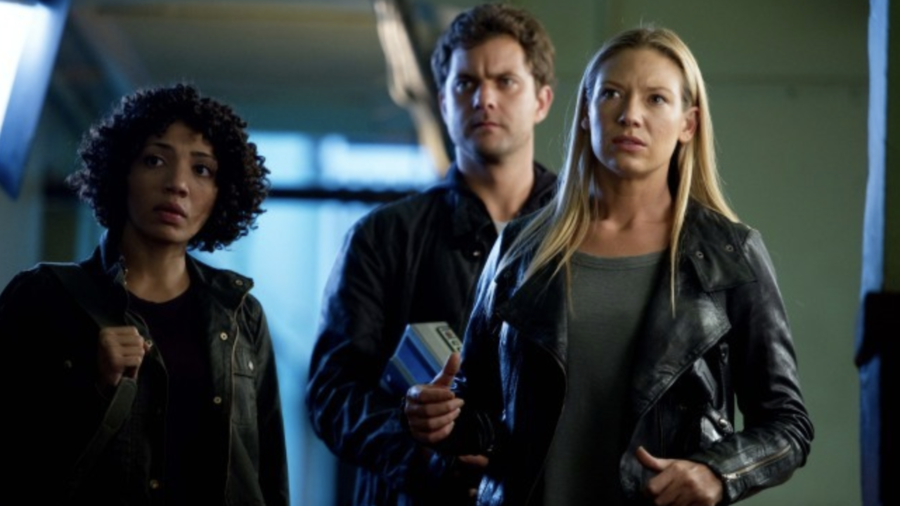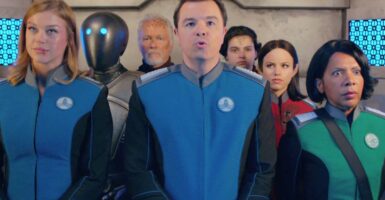The Best Fringe Episodes And Moments From The Series
Adventures in Mad Science.

It’s been years since Fringe drew to a close but for many fans, the show still very much lives on. Because the series still sits in our hearts and minds, we wanted to look back at a few of our personal favorites, the best Fringe episodes, moments, and cases. With that in mind, we have a handful of particularly memorable episodes in roughly ascending order. By no means is this an exhaustive list, and if you asked me tomorrow, it might be completely different. Fringe was just that kind of series.
Snakehead – Season 2, Episode 9

Gross giant worms. Does anything else need to be said about why this is among the best Fringe episodes? When asked which Fringe moment creeped them out the most, multiple cast members cited the mutant nematode worms from “Snakehead” as giving them the willies like nothing else.
Filming this actually made Joshua Jackson dry heave. This is one of the best creature episodes of the series.
Even with the high Fringe gross-out factor, there is an incredibly emotional component as well. When a stubborn Walter (John Noble) sets out on his own to look for clues on a case, he inadvertently puts Astrid (Jasika Nicole) and himself in danger.
Watching the scientist, so brilliant in some areas, fumble around, unable to remember where he lives or his son’s phone number, is heartbreaking.
Brown Betty – Season 2, Episode 20

For a show with as many memorable, unique monents, “Brown Betty” ranks among the best Fringe episodes.
Named after a particularly potent strain of Walter’s marijuana—any episode named after the mad scientist’s various drugs are a good time; see also “Black Blotter”—the story is notable for not only being told as a noir-style detective yarn, but also as a musical.
Getting to hear Walter sing “Head Over Heels” by Tears For Fears is a good time indeed.
A lot of people hate on the Fringe musical component of “Brown Betty.” The device is a radical departure from their usual territory, to be sure, as well as a huge risk. But it’s also a fun twist and an interesting narrative technique.
Through Walter’s storytelling in the episode, you get an oblique look at how his mind works and how he views himself. He does portray himself as the inventor of rainbows and hugs, but his self-image also has an edge of darkness and menace.
Jacksonville/ Peter – Season 2, Episodes 15 & 16

After a building from the other side merges with one from the prime universe, the Fringe team takes a road trip to Jacksonville, Florida, to the facility where Walter and William Bell (Leonard Nimoy) experimented on the Cortexiphan kids.
Given the fact that Olivia (Anna Torv) was a part of these trials, this trip stirs up some deep-seated memories and emotions. She is forced to confront her past, as is Walter, who must also try to come to terms with the questionable things he’s done in the name of science.
“Jacksonville” is one of the best Fringe episodes, the one where we first uncover Olivia’s ability to spot things from the other side, from the alternate universe. She sees a shimmery glow around the items, and the hour ends when she looks at Peter, a golden glow surrounding him.
“Peter” plays something like the second part of a to-be-continued episode. The moment when Liv realizes that Peter is not of this universe opens up a whole world of questions.
Walter breaks down the chain of events that includes his Peter getting sick and dying, creating the window into the alternate reality, and watching another version of his son dying on the other side.
Not only is this an intensely emotional episode all around—again, stirring up long-dormant feelings—this is where we learn about the extent of Walter’s interference. His meddling set the two universes on a collision course, one that may doom them both.
Events in Fringe‘s “Peter” echo even further, reaching past the point when the dual-universe drama has been largely resolved. When the Observer September (Michael Cerveris) rescues the father and son from the frigid waters of Reiden Lake, this plays a part in his path as well.
As we learn in the final season, September was influenced by the love between fathers and sons—largely between Walter and Peter—which leads him away from the emotionless, entirely rational nature of his kind.
Letters Of Transit – Season 4, Episode 19

“Letters of Transit” transports the Fringe team to 2036, when the Observers have taken over.
This episode sets the stage for the finale of Fringe—this is the world where the fifth and final season takes place. It also ups the stakes yet again, both as the individual characters are concerned, and for the entire human race. We also get introduced to Henrietta (Georgina Haig), the heretofore-unknown daughter of Peter and Olivia.
This is also indicative of the show’s courage and willingness to take risks. Even though they knew they would likely be canceled soon, that knowledge didn’t stop the show’s writers from staying true to the spirit of the show and pushing it in directions that no one expected.
Liberty/ An Enemy Of Fate – Season 5, Episodes 12 & 13

Though envisioned as two distinct episodes, “Liberty” and “An Enemy of Fate” were presented as what was essentially one two-hour series finale.
Five years built toward this, and even though it wasn’t a perfect send-off—no conclusion will ever please everyone—the finale does a worthy job of wrapping things up, which is why putting it this close to the top of my list feels like an appropriate choice.
These two episodes are full of fun little nods to longtime fans of Fringe, like the when Peter and Olivia storm the Observers HQ using a bunch of old Fringe cases as ammunition—they unleash the butterflies from “Dreamscape” and the worms from “Snakehead,” among others.
You get to say goodbye to old friends like Fauxlivia and Lincoln Lee (Seth Gable). And most importantly, the characters get exactly what they need. It may not always be the easiest path, but in the end, they do what they must to find redemption. All in all, the series ends on more of a positive note than many of us expected.
Pilot – Season 1, Episode 1

While this maybe may not be the best episode from a quantifiable standpoint, the more I think about it, the harder it is to place the pilot episode anywhere but in the number one spot.
This is, after all, the episode that started it all, that introduced us to an upstart young FBI agent, an institutionalized mad scientist, his globe-trotting con man of a son, and a whole bunch of weird-ass shit.
I didn’t give Fringe a fair shake until the first season came out on DVD, in part because I didn’t have access to network TV at the time and partly because I dismissed it as an X-Files knockoff.
As important as all the craziness is to Fringe—and there’s a good deal of that in the pilot, what with the guy disintegrating on an airplane—the show has always been about the relationships between the characters. Though it takes time to establish those, this is where all of that starts.
The moment when Fringe first clicked for me, when I really thought that this was something I could get behind, was when we first meet Walter.
He’s sitting there in Sinclair’s, disheveled and insane looking, and there’s such an overwhelming sadness about him. This is one of the most enduring images of the show. That feeling infuses everything he does as the series progresses.
As giddy and lighthearted as he can be as he waxes philosophical about a particularly memorable batch of blotter acid, the weight of every terrible thing he’s ever done is always right there with him. He feels the consequences so acutely that he can never escape his past, all he can do is attempt to make amends. This carries through to the final moments of the series.












